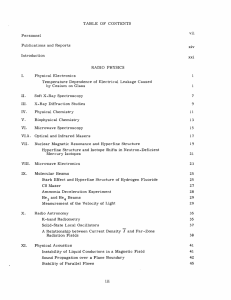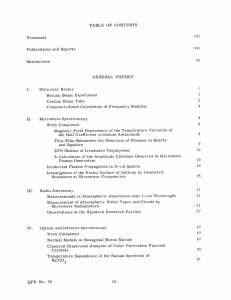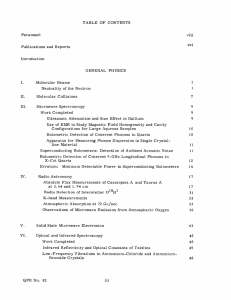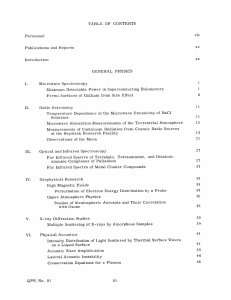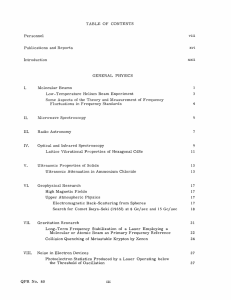XXII. GASEOUS ELECTRONICS* Academic and Research Staff
advertisement
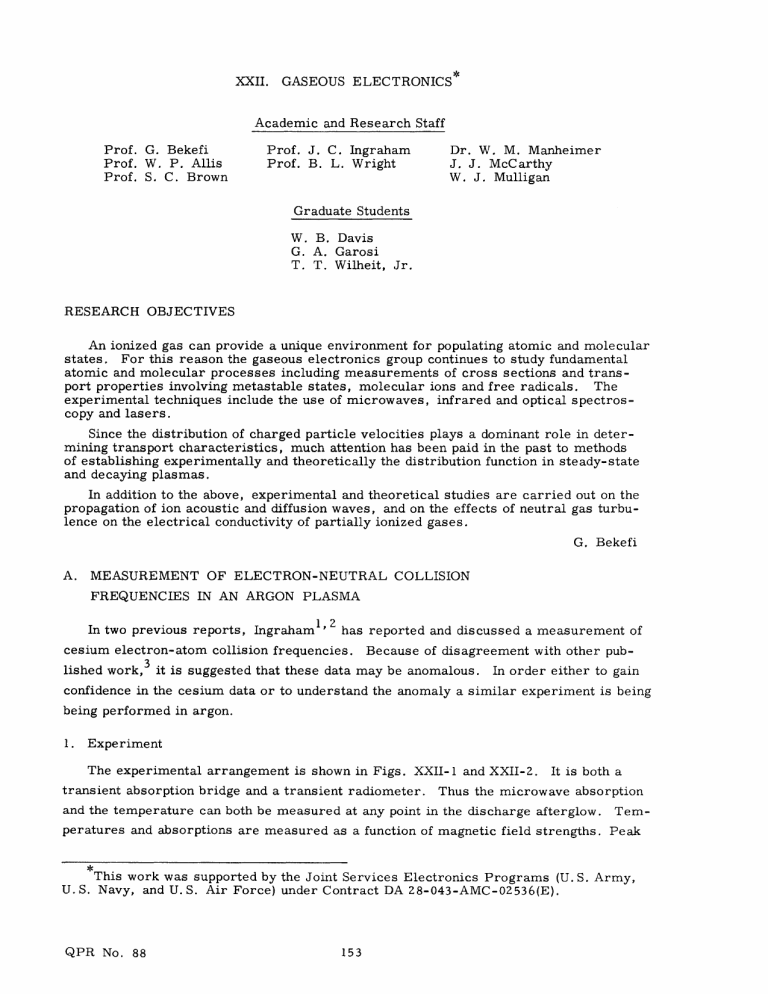
XXII.
GASEOUS ELECTRONICS*
Academic and Research Staff
Prof. G. Bekefi
Prof. W. P. Allis
Prof. S. C. Brown
Prof. J. C. Ingraham
Prof. B. L. Wright
Dr. W. M. Manheimer
J. J. McCarthy
W. J. Mulligan
Graduate Students
W. B. Davis
G. A. Garosi
T. T. Wilheit, Jr.
RESEARCH OBJECTIVES
An ionized gas can provide a unique environment for populating atomic and molecular
states. For this reason the gaseous electronics group continues to study fundamental
atomic and molecular processes including measurements of cross sections and transport properties involving metastable states, molecular ions and free radicals. The
experimental techniques include the use of microwaves, infrared and optical spectroscopy and lasers.
Since the distribution of charged particle velocities plays a dominant role in determining transport characteristics, much attention has been paid in the past to methods
of establishing experimentally and theoretically the distribution function in steady-state
and decaying plasmas.
In addition to the above, experimental and theoretical studies are carried out on the
propagation of ion acoustic and diffusion waves, and on the effects of neutral gas turbulence on the electrical conductivity of partially ionized gases.
G. Bekefi
A.
MEASUREMENT OF ELECTRON-NEUTRAL COLLISION
FREQUENCIES IN AN ARGON PLASMA
In two previous reports, Ingrahaml 2 has reported and discussed a measurement of
cesium electron-atom collision frequencies.
Because of disagreement with other pub-
lished work,3 it is suggested that these data may be anomalous.
In order either to gain
confidence in the cesium data or to understand the anomaly a similar experiment is being
being performed in argon.
1.
Experiment
The experimental arrangement is shown in Figs. XXII-1 and XXII-2.
transient absorption bridge and a transient radiometer.
It is both a
Thus the microwave absorption
and the temperature can both be measured at any point in the discharge afterglow. Temperatures and absorptions are measured as a function of magnetic field strengths. Peak
This work was supported by the Joint Services Electronics Programs (U. S. Army,
U. S. Navy, and U. S. Air Force) under Contract DA 28-043-AMC-02536(E).
QPR No. 88
153
(XXII.
GASEOUS ELECTRONICS)
'- --K
KLYSTRON 5500 MHz
I
I70-dB ATTENUATOR
L._ __.
NOISE STD
18,000 -K
CALIBRATED
MICROWAVE ATTENUATOR
(TEMPERATURE)
SWITCHING
DIODE DIO
MAGIC
E
TEE
I
CALIBRATED
ATTENUATOR
(PLASMA
--ABSORPTION)
I
2'
MICROWAVE
SWITCHING
IODE
DIODE
MATCHED
LOAD
30-MHz GATED
IF AMPLIFIER
SYNCRONOUS
DETECTOR
Fig. XXII-1.
Experimental arrangement.
absorption occurs at electron-cyclotron resonance, and the value at the peak is typically from 0. 1 dB to 10 dB for the 22-cm absorption length.
range from 300°K to 1500 K.
Typical temperatures
If the measured temperature is independent of magnetic
field, the electron velocity distribution
is assumed to be Maxwellian.
sic\/
The operation of the apparatus has
been described previously in detail by
Ingraham. 1
Some changes have been
made in the microwave circuit since it
was previously described. The isolation
of the adjacent channels of the ferrite
switch is only approximately 20 dB.
B AN D
MICROWAVE
CHOKES
CWAVEGUIDE
Because of the coherence of the two signals, this results in some sensitivity to
ARGON
TUBE
Fig. XXII-2.
QPR No. 88
the phase shift introduced by the plasma.
To correct this, two microwave switching
Detail of discharge tube and
waveguide.
154
(XXII.
GASEOUS ELECTRONICS)
diodes have been added to give approximately 40 dB isolation.
switching diodes made an additional isolator necessary.
Reflections from the
The phase sensitivity has been
measured with the phase shifter in the plasma arm of the microwave bridge.
We found
it to be absent, within experimental error.
The cesium tube has been replaced with a sealed argon discharge tube.
Pressures
are changed by changing tubes.
The parametric amplifier was added to give added sensitivity in the temperature
measurements.
With this parametric amplifier the entire system has a noise figure
around 4 dB.
2.
Theoretical Considerations
In a previous report, 3 the author has sketched the derivation of the power absorption
coefficient
2
p
2dxdy
(W
a =
kc vTab
where
2
2 2
sin2
x +y = p
3-
0
p is the electron plasma frequency (noe2/E
shown in the previous report
3
Z
a
2
2
O
m)
, and vT - (KT/m)1/ 2 .
It was
that the Doppler shift term, (kv ), could be ignored for
the experimental conditions in question.
4p2
2
d v( - V f
v c +(w-kv /c z
-
This left us with
2/y\
oo
dvv4
0
c0
+
dxdy sin
3kc VTab
co
The basic assumption made here is that the plasma does not significantly alter the wave2
2
guide fields. Clearly, this is true in the limit w - 0. But, in reality, w is not zero,
An exact calculation to second order in o2 would
p
In this report, several heuristic models are presented in order
so this expression for a is not exact.
be extremely difficult.
to estimate possible second-order effects.
These will be called, for lack of more
descriptive names, "finite k. effect," "upper hybrid effect," "phase velocity effect," and
1
"dielectric rod effect."
a.
Finite ki Effect
Willett 4 has shown that if we allow for the fact that the attenuation length is finite,
there is then an imaginary part to the propagation constant k, and a term similar to
a Doppler shift arises
QPR No. 88
155
(XXII.
GASEOUS ELECTRONICS)
2
W2
2
a Tab
2 2
+y =p
(.r)
dxdy sin (-
0
kc vTab
T
2
)
$
d 3 v(v)
dV x
co
v f
(v -kiv )2 + (0C 1Z
where k i is the imaginary part of k. As in the previous report,
velocity directions and define a resonance function
2
)
R. F.(
_
2
2o
_ 2 2+k
1
log
log
c
i
- tan
3 3
2ki
c
2 2
k v
k.
an13 3
1
2
c
(W-)
-1
t-Q
3
)
we can integrate over
+ (Vc+kiv)
v - kiv
c¢e-0 -
This has a half-width at half-maximum of approximately
[12
7(ki)
2
2]
1/2
or in terms of a collision probability
A1/2
-[2
1/2
7(ki) j
22
cPO - 0. 7(k )
V,
O
where Pc is the collision probability at 1-Torr pressure, po is the pressure in Torr,
and (ki)o is the peak value of the imaginary part of the collision frequency. This gives
2
22
a 1% error when 0. 7(ki)o /Po
= 0. 02. The minimum value for Pc for argon is approximately 0. 5 cm1 Torr . In this experiment, p = 10 Torr. Thus, for 1% error, k. =
-1
o
1
0. 85 cm . In this experiment, the absorbing length is 22 cm, which corresponds to
160 dB power attenuation by the plasma. Therefore this effect is not large for 0.1-10 dB
range of the present experiment.
b.
Upper Hybrid Effect
In the calculation we have ignored the fact that the magnetic and propagation axes differ by 5.7* (see Fig. XXII-2). So, rather than have a resonance
at the electron-cyclotron resonance frequency, we might expect the resonance
to be that of a right-handed wave propagating
netic field.
at an angle of 5. 7
to the mag-
and Bers 5 give for the index of refraction of a right-handed
wave in an electron plasma:
Allis,
Buchsbaum,
QPR No. 88
156
(XXII.
GASEOUS ELECTRONICS)
2 (WZ/2)( 1- W/W)
= 1 --
n
(
-Z-z
2
sin
0-D
where
2
D
2
4
a2
4
=-sin
42
+
-
P
c
cos
.
For our case,
2
sinE8<<
cos
0,
so
22
n
2
p
= 1(2/W2)
1-
sinz
2
p
cos
-
p
2
n
-
1-2/W2) sin2 0
/w
with sin2 0 = 0. 0100. Thus the resonant frequency for a right-handed wave propagating
at 5.7
with respect to the magnetic field is 0 + 0. 0005 w2/W
p
2
If we substitute this value in our expression for a, consider w a function of position,
P
and approximate v c by a constant, we get
2 ('ry\
dxdy sin0 (-a-.
2
S-
2
W(x, y)
v
- 0.005p (+
V
Approximate the plasma profile by
QPR No. 88
157
(XXII.
GASEOUS ELECTRONICS)
2
W (x, y)
=
p
2 (x,
p
2
po
2
x22 +yy
for x 2 + y
1
<p
for x 2 + y2 > p
y) = 0
Approximate sin2 (ry/a) by 1 for the region in which o2
p
22
2k
2
po
a=
log
abk (Wzp/WV
gp
5
2. 5 X 10
Wp 2
o
(
/v
0.
- 102
1
-c
I)
c)
2
+ 2
-
itan-1 5 X
vc
t
) ta
10 -
3
2
10
\oyV
_
3
- tan-1
Note that the absorption depends only on the dimensionless ratios (c2 o/wvc) and
(w-2/v).
(vc).
Thus for constant peak absorption the broadening is proportional to pressure
This function was calculated numerically on an IBM 360/65 computer for the pres-
ent experimental case (5. 5 GHz in C-band waveguide), and for a 1-cm inner diameter
of the discharge tube.
The result may be scaled to other tube diameters by noting that
the total peak absorption is proportional to the square of the inner diameter of the discharge tube.
tion.
We found that the resonance is broadened by 1% for -390 dB total absorp-
In the data presented here, the discharge tube I. D. was 0. 6 cm, so this is reduced
to 1% broadening for ~110 dB absorption.
Thus, once again, we have an effect that may
be ignored in the present experiment.
c.
Phase Velocity Effect
Notice that a is proportional to w/k = vp, the phase velocity of the electromagnetic
wave.
The presence of the plasma does alter this phase velocity. If the waveguide were
filled with a uniform isotropic dielectric, the dispersion relation would be k 2 + iz/a2 =
K w2/c2
k =
K
w/c2 -
/a2
where K is the dielectric coefficient.
Consider the waveguide to be uniformly filled
with plasma at an averaged density
<n> = ab
QPR No. 88
dxdy n(x,y) sin2
.
158
(XXII.
GASEOUS ELECTRONICS)
The weighting factor of sin2(wy/a) occurs because the energy dissipation at any point
is proportional to the square of the magnitude of the electric field strength.
For the
lowest waveguide mode (TE 0 1), the electric field has the form
E = Ejx sin cos (kz-t).
2
( a )
For the dielectric constant K, take the diagonal part of the cold-plasma dielectric ten5
sor.
The resulting half-widths have been calculated numerically on an IBM 360/65 computer.
Again the broadening is dependent only on the peak absorption.
1% broadening occurred for a peak absorption of 15 dB.
We found that
This may again be neglected
in the present case.
d.
Dielectric Rod Effect
In all of these models we have assumed that the interaction between the plasma and
the electromagnetic wave was essentially that of a plane wave propagating through an
infinite plasma.
The actual geometry is quite the opposite, however.
Fig. XXII-3.
The dimensions
Two-dimensional dielectric rod
problem.
r=p
of the plasma perpendicular to the direction of propagation are much smaller than a
wavelength. The interaction can be modeled in the quasi-static approximation, in which
we approximate the electric fields as the gradient of a scalar potential. We also approximate the plasma by a uniform rod of gyrotropic dielectric of radius P.
The resulting two-dimensional problem is illustrated in Fig. XXII-3.
scalar potential for r > p.
QPR No. 88
159
Let
1 be the
GASEOUS ELECTRONICS)
(XXII.
= -Er
0
A
B
sin 0 + A-sin 0 + -B
r cos 08,
r
and for r < p,
€2 = Cr sin 0 + Dr cos 0.
For r < p, we have a two-dimensional dielectric tensor K such that
D = EoKE
o=
o
D x
-K X
K
Using continuity of
E
1 and the normal component of D at the boundary r = p, we can
determine the electric field inside the plasma.
E.
2E[(1 +K )x-Kxy]
(I+K) 2 + (Kx)2
inside
A
A
where x and y are unit vectors in the x and y directions, respectively.
power absorption is proportional to E*
5
Buchsbaum, and Bers, are
K
E.
The values of K and Kx
The rate of
,
from Allis,
2
1
K
= 1
+iv
-2
c
K
-
i
-2
+ P2
iv
K
Hence the resonance
is shifted by an amount w2/2w. To estimate the magnip
tude of this effect for the present measurements, we make the very crude approximation that this
QPR No. 88
shifted resonance
describes the absorption at each
160
point in an
(XXII.
GASEOUS ELECTRONICS)
inhomogeneous plasma.
If we approximate the plasma profile by a parabola, we have
an expression identical formally to the expression for the "upper hybrid effect." The
(D
z
w
0
Fig. XXII-4.
m l
z
w
Broadening attributable to the
"dielectric rod effect."
U
w
9-
2
5
10
20 xdB/cm
2
only difference is that we now get the same broadening for 1/100 of the density.
That
is,
1% broadening occurs for 3. 9 dB for a 1-cm I. D. discharge tube. Similarly,
for the 0.6 cm I.D. tube of the present experiments, 1% broadening occurs at
1. 1 dB.
This must be considered in evaluating the data.
Figure XXII-4 is a plot
of
peak power absorption in dB
2
(inner diameter of the discharge tube)
against percentage of broadening.
3.
Experimental Results
We
<2 dB.
shall
consider the second-order
This gives ~4% error, because
effects are smaller.
effects.
effects negligible
of the "dielectric
for peak absorption
rod effect." The other
We shall only use the data for which we can ignore these
A typical data run,
showing absorption and temperature measurements
versus magnetic
field, is shown in Fig. XXII-5. In Fig. XXII-6, we show measured half-widths versus temperature for 20.0-Torr argon pressure. Ingraham2
has
calculated half-widths from the data of Frost and Phelps.6
also in Fig.
culated.
XXII-6.
The dashed portion is
Figure XXII-7 shows the same for
an extrapolation;
161
it
10.0-Torr pressure.
tainties in the half-widths are essentially the uncertainties
QPR No. 88
These are shown
was not calThe uncer-
in individual points
(XXII.
GASEOUS ELECTRONICS)
near the half-maximum in the raw data.
Another way to analyze the data is to note that the ratio of the peak absorption
1000
900
800
I
T= 760
+
40 'K
700
1.2
1.0
I
I
I
0L
125
140
135
MAGNETIC
I
FIELD (ARBITRARY UNITS)
Typical data run.
Fig. XXII-5.
to the area under the absorption curve is equal to
irv ,
)4f
v
(
dv
v 4 fo dv
c /
=
Ingraham 2 has calculated these
20.0 Torr, respectively
in
Figs.
are
XXII-8 and XXII-9.
the contribution to the
the wings.
averages also.
form A/(-)
+ 62,
The large error bars
area under the
10.0 Torr
-
f)
and
calculations
result from approximating
curve from the unmeasured portions
2-
dependence.
in
A numerical fit of the
where A and 6 are fitted to the data in the wing, would
improve this.
QPR No. 88
data for
shown and compared with Ingraham's
We have assumed an (
2
The
162
5 x 10
I
SI
400
Fig. XXII-6.
I
I
600
TEMPERATURE
I
I
1000
2000
(OK)
Half-width data for 20. 0-Torr pressure.
5 x 107
I
I
400
I
I
600
I
TEMPERATURE
Fig. XXII-7.
QPR No. 88
I
I
1000
(OK)
Half-width data for 10. 0-Torr pressure.
163
2000
7
6x 10
-
7
5 x 10
4 x 107 -
3 x 10
2 x 107
k
~~
I
I20 0
20(0
I
II
400
300
-1
Fig. XXII-8.
I
~
500
I
I
600
I
800
~
I
1000
2000
data for 10. 0-Torr pressure.
x 107 r
5 x 10
4 x 10
3 x 10-
2x 10
107I 0
20 0
Fig. XXII-9.
QPR No. 88
II
300
v
Ii
400
-
)
-1
II
500
II
600
II
II
II II
800
1000
I
2000
data for 20. O-Torr pressure.
164
(XXII.
4.
GASEOUS ELECTRONICS)
Conclusion
The agreement between calculations and measurements seems reasonably good.
Certainly, if there were an anomaly in Ingraham's data, it is not present here.
This
gives added confidence to Ingraham's data, and, incidentally, to the argon data of Frost
and Phelps.
T. T. Wilheit, Jr.
References
1.
J. C. Ingraham, Quarterly Progress Report No. 77, Research Laboratory of Electronics, M.I.T., April 15, 1965, pp. 113-118.
2.
J. C. Ingraham, Quarterly Progress Report No. 81, Research Laboratory of Electronics, M.I.T., April 15, 1966, pp. 63-67.
3.
T. T. Wilheit, Jr., Quarterly Progress Report No. 86, Research Laboratory of
Electronics, M.I.T., July 15, 1967, pp. 138-142.
4.
J. E. Willett, J. Appl. Phys. 33, 898 (1962).
5.
W. P. Allis, S. J. Buchsbaum and A. Bers, Waves in Anisotropic Plasmas (The
M.I.T. Press, Cambridge, Mass., 1963).
L. S. Frost and A. V. Phelps, Phys. Rev. 136, A1538 (1964).
6.
QPR No. 88
165

